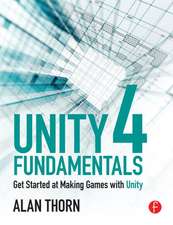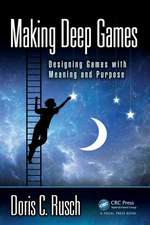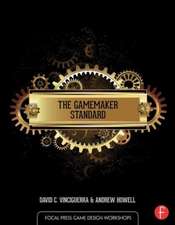Interactive Storytelling for Video Games: A Player-Centered Approach to Creating Memorable Characters and Stories
Autor Josiah Lebowitz, Chris Klugen Limba Engleză Hardback – 2 aug 2017
| Toate formatele și edițiile | Preț | Express |
|---|---|---|
| Paperback (1) | 274.28 lei 3-5 săpt. | +47.04 lei 7-13 zile |
| CRC Press – mar 2011 | 274.28 lei 3-5 săpt. | +47.04 lei 7-13 zile |
| Hardback (1) | 980.89 lei 6-8 săpt. | |
| CRC Press – 2 aug 2017 | 980.89 lei 6-8 săpt. |
Preț: 980.89 lei
Preț vechi: 1427.06 lei
-31% Nou
Puncte Express: 1471
Preț estimativ în valută:
187.70€ • 204.70$ • 158.27£
187.70€ • 204.70$ • 158.27£
Carte tipărită la comandă
Livrare economică 24 aprilie-08 mai
Preluare comenzi: 021 569.72.76
Specificații
ISBN-13: 9781138427464
ISBN-10: 1138427462
Pagini: 332
Dimensiuni: 191 x 235 mm
Greutate: 0.78 kg
Ediția:1
Editura: CRC Press
Colecția Routledge
ISBN-10: 1138427462
Pagini: 332
Dimensiuni: 191 x 235 mm
Greutate: 0.78 kg
Ediția:1
Editura: CRC Press
Colecția Routledge
Public țintă
Professional Practice & DevelopmentRecenzii
Lebowitz and Klug's tag-team approach to the subject makes this an engaging read, even for seasoned interactive storytellers. The combination of Lebowitz's theory and Klug's field experience present both new and experienced game writers with both the promises, and the challenges, of experimenting with game narratives. The use of diverse case studies, which cover everything from the classic Final Fantasy VII to the Japanese visual novel genre, provide readers with the opportunity to engage Lebowitz and Klug's ideas and inspire innovation in their own writing. The exercises and questions both guide readers through the key points, and encourage application and exploration, perfect for a classroom setting.
-Kathleen Dunley, Faculty Chair-English, Rio Salado College
Interactive Storytelling in Games is a great primer for students, educators, and writers looking to move into this increasingly prominent profession. The authors explain branching dialogue clearly and carefully, covering many details that are ordinarily lost on writers of other types of fiction, as well as the designers of many games! This book will help you understand what makes games tick, how to tell stories using them, and what players really want out of their games and stories. It's thought-provoking, intelligent, and founded on a combination of experience and research that's hard to match.
-Chris Keeling, Course Director, Game Design, Full Sail University; Executive Committee Member, IGDA Game Writing SIG
Lebowitz and Klug's tag-team approach to the subject makes this an engaging read, even for seasoned interactive storytellers. The combination of Lebowitz's theory and Klug's field experience present both new and experienced game writers with both the promises, and the challnges, of experimenting with game narratives. The use of diverse case studies, which cover everything from the classic Final Fantasy VII to the Japanese visual novel genre, provide readers with the opportunity to engage Lebowitz and Klug's ideas and inspire innovation in their own writing. The exercises and questions both guide readers through the key points, and encourage application and exploration, perfect for a classroom setting.
-Kathleen Dunley, Faculty Chair-English, Rio Salado College
-Kathleen Dunley, Faculty Chair-English, Rio Salado College
Interactive Storytelling in Games is a great primer for students, educators, and writers looking to move into this increasingly prominent profession. The authors explain branching dialogue clearly and carefully, covering many details that are ordinarily lost on writers of other types of fiction, as well as the designers of many games! This book will help you understand what makes games tick, how to tell stories using them, and what players really want out of their games and stories. It's thought-provoking, intelligent, and founded on a combination of experience and research that's hard to match.
-Chris Keeling, Course Director, Game Design, Full Sail University; Executive Committee Member, IGDA Game Writing SIG
Lebowitz and Klug's tag-team approach to the subject makes this an engaging read, even for seasoned interactive storytellers. The combination of Lebowitz's theory and Klug's field experience present both new and experienced game writers with both the promises, and the challnges, of experimenting with game narratives. The use of diverse case studies, which cover everything from the classic Final Fantasy VII to the Japanese visual novel genre, provide readers with the opportunity to engage Lebowitz and Klug's ideas and inspire innovation in their own writing. The exercises and questions both guide readers through the key points, and encourage application and exploration, perfect for a classroom setting.
-Kathleen Dunley, Faculty Chair-English, Rio Salado College
Cuprins
Chapter 1 Game Stories, Interactivity, and What Players Want; Chapter 2 A Brief History of Storytelling in Games; Chapter 3 The Hero’s Journey and the Structure of Game Stories; Chapter 4 The Story and the Characters; Chapter 5 Making Stories Emotional; Chapter 6 Defining Interactive and Player-Driven Storytelling; Chapter 7 Fully Traditional and Interactive Traditional Stories; Chapter 8 Multiple-Ending Stories; Chapter 9 Branching Path Stories; Chapter 10 Open-Ended Stories; Chapter 11 Fully Player-Driven Stories; Chapter 12 The Argument for the Supremacy of Player-Driven Storytelling; Chapter 13 The Argument Against the Supremacy of Player-Driven Storytelling; Chapter 14 What Players Really Want: The Most Important Issue; Chapter 15 The Future of Storytelling in Games;
Descriere
What really makes a video game story interactive? What's the best way to create an interactive story? How much control should players be given? Do they really want that control in the first place? Do they even know what they want-or are their stated desires at odds with the unconscious preferences? This book examines these questions and more.










